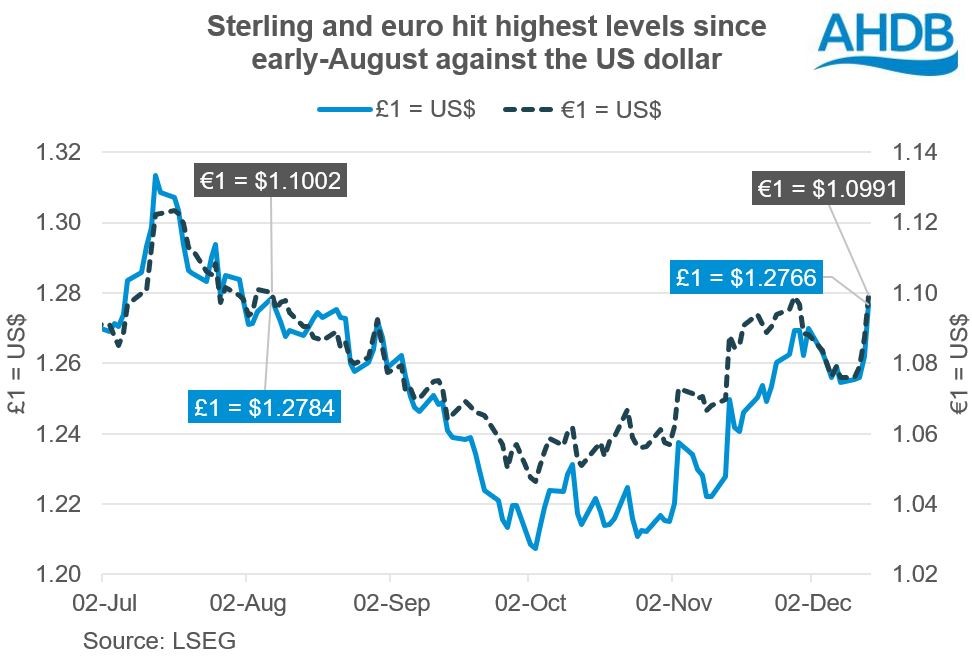Sterling strength weighs on UK prices: Grain market daily
Friday, 15 December 2023
Market commentary
- Exchange rates were an important factor for wheat markets yesterday. As a result of the stronger euro and pound against the US dollar (more below), European wheat prices fell while the US markets rose.
- Chicago wheat futures (May-24) gained $3.40/t to $229.90/t supported by a weaker US dollar, buying by speculative traders and strong trade data. The weekly trade data was the strongest on record due to the inclusion of previously announced sales to China.
- Meanwhile, in UK feed wheat futures, the May-24 contract fell £0.60/t to close at £194.50/t, while the Nov-24 contract fell £0.25/t to £207.00/t. The Paris wheat futures May-24 contract fell €4.00/t to €228.50/t.
- May-24 Paris rapeseed futures lost €3.50/t yesterday to close at €435.00/t (approx. £374.00/t), while the Nov-24 contract lost €5.25/t to €439.00/t (approx. £377.50/t). This contrasted with small gains for Chicago soybean futures on the back of worries about Brazilian weather and strong demand for US soyabeans. The USDA reported an export sale of 400 Kt yesterday, with industry crush data expected later today.
Sterling strength weighs on UK prices
UK and Paris wheat futures prices fell under pressure from exchange rate changes yesterday, despite price rises in the US markets. Both the euro and pound reached multi-month highs against the US dollar, which pushed on European prices. In contrast, the weaker US dollar added to support for US prices.
The key factor supporting sterling was the Bank of England (BoE) holding interest rates unchanged for the third time a row at 5.25%. The BoE also indicated that need to stay high for ‘sufficiently long’ to return inflation to the bank’s target. Similarly, the European Central Bank held interest rates across the eurozone at 4.5%, while warning that inflation was likely to pick up in the months ahead.
Although the US Federal Reserve also kept its interest rate stable, the messaging was very different as the Chair indicated that rate cuts could be ahead in 2024. This tone of message wasn’t expected, which triggered a weakening in the US dollar.
Euro not helping EU exports
A stronger currency and exchange rate make that country’s products less competitive on export markets compared to other sources. As a result of the stronger euro, Paris wheat futures prices came under pressure yesterday. EU-27 exports are already struggling against cheaper Black Sea supplies. The latest data offered no respite, with total wheat exports by 10 December still 14% behind last year’s pace.
If the euro remains stronger against the US dollar, it won’t help the struggling export pace, which is turn could well continue to weigh on prices. The issue will be could the size of the potential build-up of stock in 2023/24. Although there are indications of lower wheat plantings in France for the 2024/25 season, larger stocks could at least partly offset any potential dip in production.
If there is pressure on Paris wheat futures, this is likely to filter through the UK prices.
Stronger sterling to keep UK imports higher?
Although UK wheat prices are closer to attracting imports than exports, exchange rates are still important to UK competitiveness. Stronger sterling makes imports more attractive at the same price point. If sterling remains strong against the US dollar going forward, it could keep stronger grain imports. However, the strength of the pound against the euro will also be important as the eurozone remains an important supplier of grain to the UK.
The latest HRMC trade data out yesterday, shows the pace of UK wheat imports remained strong in October, with a further 165 Kt imported. This takes the 2023/24 season to date total (Jul – Oct) to 581 Kt, 20% more than the first four months of last season. Total wheat imports this season are expected to be 6% higher at 1.43 Mt.
Maize imports also picked up in October at 148 Kt from 136 Kt in September, although the year-to-date total is still 19% behind last season’s pace. Total 2023/24 imports are forecast to rise 7% year-on-year, so this pace needs to be monitored.
Oat (and to a lesser extent barley) exports so far are stronger than might be expected given the smaller crop sizes. However, this is likely linked to the lower quality availability in mainland Europe. The strength of sterling, particularly against the euro, may impact the pace of these exports in the months ahead. Meanwhile, wheat exports remained slow in October, with just 20 Kt shipped.
Sign up
You can subscribe to regular updates straight to your inbox. Create a free account on our Preference Centre and select the information you wish to receive.
While AHDB seeks to ensure that the information contained on this webpage is accurate at the time of publication, no warranty is given in respect of the information and data provided. You are responsible for how you use the information. To the maximum extent permitted by law, AHDB accepts no liability for loss, damage or injury howsoever caused or suffered (including that caused by negligence) directly or indirectly in relation to the information or data provided in this publication.
All intellectual property rights in the information and data on this webpage belong to or are licensed by AHDB. You are authorised to use such information for your internal business purposes only and you must not provide this information to any other third parties, including further publication of the information, or for commercial gain in any way whatsoever without the prior written permission of AHDB for each third party disclosure, publication or commercial arrangement. For more information, please see our Terms of Use and Privacy Notice or contact the Director of Corporate Affairs at info@ahdb.org.uk © Agriculture and Horticulture Development Board. All rights reserved.



